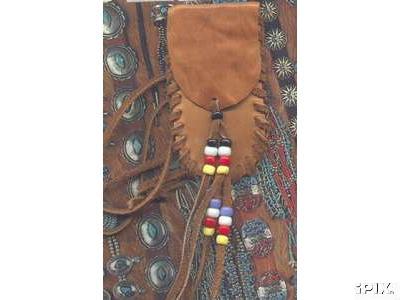

Medicine bag: This elk skin (buckskin) medicine bag is made by Floyd Moose on the Pine Ridge Indian Reservation in South Dakota. It is 4" by 2" and is BROWN in color... It comes with authenticity tag... $18.00

9585 This beautiful dead pawn bracelet is an amazing work of Native American art. The eye-catching cuff bracelet has two coral stones and one turquoise stone set in to a silver band. The coral stones measure 5/16” x 1/8” and are separated by beautiful silver raindrops. The rose red coral stones stand out beautifully against the shinny silver band. The turquoise stone measures ½” x 3/8”.This cuff bracelet measures 1" across at the center and is both signed by the artist and stamped sterling. The bracelet, which can be stretched or squeezed a bit for fitting, has an inside circumference of 7" including the 1 1/8 " opening. It is from dead pawn from the Gallup area. For the Southwestern Native American, pawn refers to the practice of converting artwork and possessions into income for life's necessities. Pawn can also be items from antiquity, heirloom pieces of handmade jewelry or craft, passed from a family into the public marketplace. Because much of the pawned merchandise is of real day-to-day value in the seller's life, the percentage of pawn that goes unredeemed is small, about five percent. Merchandise that remains for sale after expiration is referred to as "dead pawn", and items of dead pawn are among the most highly valued Native American artifacts to be found on the open market. Price: $65
"Turquoise is a blue to blue-green mineral of aluminum and copper, mainly, prized as a gemstone in its polished blue form. It derives its name from turc (Turkish in French) as it was transported to Europe through Turkey. It is one of the oldest known gem materials. Turquoise is a secondary mineral deposited from circulating waters, and it occurs chiefly as an opaque, granular vein running through a host rock. Ancient manuscripts from Persia, India, Afghanistan, and Arabia report that the health of a person wearing turquoise can be assessed by variations in the color of the stone and was also thought to promote prosperity.
Turquoise is an important ornamental mineral for jewelry and adorned the ceremonial dress of early native Americans. It is believed that the gemstone guards against diseases and assists in tissue regeneration, subtle body alignment and strengthening. It also brings good fortune and attracts healing spirits. Delicate veining, caused by impurities, is desired by some collectors as proof of a natural stone. Rich deposits of turquoise are found in the regions of Iran, southwestern United States, Africa, Australia, Tibet, China, Siberia and Europe."